Welcome to the second blog post in a series of six about SEO planning for 2021. This post required a lot of research because the topic is so vast. I have tried to consolidate as much information as possible into a relatively small space, but there is a ton of additional recommended reading at the end of this article that is worth pursuing. To provide a structured overview of what I am going to be covering in this post, here's an outline:
- Why Content is Still King for B2B and SEO
- Why B2B Content Strategy is More Than Producing Content for Potential Customers
- How Does SEO Influence Your B2B Content Strategy?
- What is Topical Authority and Why is It Important for SEO?
- What are Pillar Pages?
- What are the Most Effective B2B Content Marketing Strategies to Create Successful SEO Performance?
It is my hope that this article will give you a new perspective on your B2B content marketing strategy and planning for 2021, and better equip you to create a long term, sustainable roadmap to consistent SEO performance that generates revenue and ROI.
To start, let's briefly explore why content is still so important for success.
Why Content is Still King for B2B and SEO
I know what you're thinking. If you have been involved with digital marketing for any reasonable amount of time, you are most likely ready to tell me that the phrase 'Content is King' is a played-out, cliche, underscores the obvious, and that if you didn't appreciate the importance of content for B2B marketing as it relates to SEO success, you wouldn't be reading this blog post. Those are fair points and I agree. But before I dive into more meaningful discussions, I want to level-set with a couple concepts that might not be as intuitive and I think bear mentioning.
First things first: Most B2B purchases are still made offline, and while the pandemic is certain to accelerate the adoption of online B2B purchases, online still represents the tip of the iceberg as evidenced by the following data:

Essentially this data says that, as we are headed into 2021, only about 17% of B2B sales are generated digitally. However, the other 83% are likely significantly impacted by the content you produce even though you may not be able to measure that dynamic.
While closed loop reporting, improved attribution models, sophisticated marketing automation and CRM systems, and ABM tracking software leveraging AI to understand intent and buying signals at the account level have all improved our ability to understand the impact of content on the buyer journey, these numbers would imply that we are still significantly under-appreciating the impact that our content actually has on purchases and revenue.
Consider the following statistic from a FocusVision study on B2B buying trends:
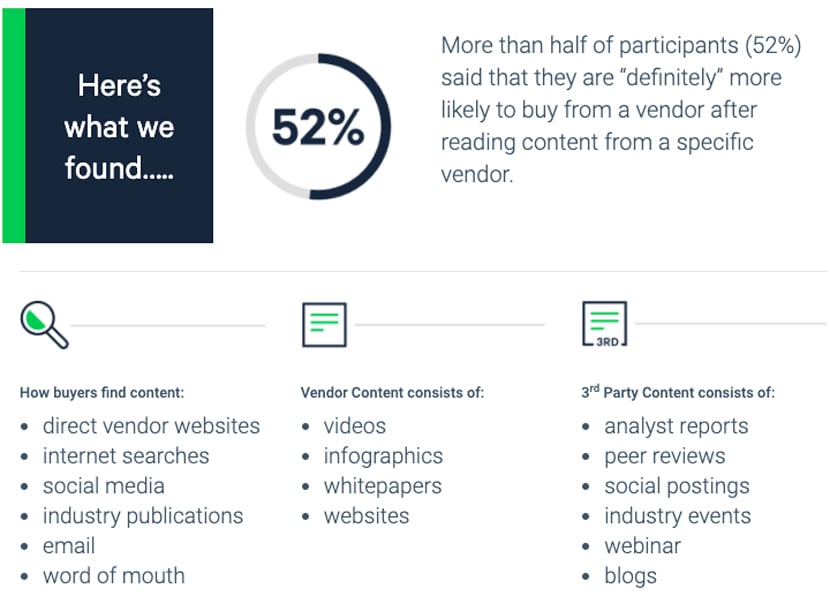
Not only did they find that 52% of their B2B purchasing respondents were definitely more likely to buy from a vendor after reading their content, but they consumed over 13 pieces of content during their journey!
Additionally, 63% had a buying team of 3 to 4 people, and 73% took between 2 to 6 weeks to make a decision:

There are a number of other B2B studies and data points that paint the same picture. The B2B sales cycle is long, complex, and difficult to measure based on the numbers of interactions, people involved and devices they use for a potential account. Having the right closed loop reporting solutions can vastly improve your ability to understand user behavior, but many B2B companies have significant reporting deficiencies and are unaware of the importance their content is having on the sales cycle.
Understanding the data we just looked at, in terms of content consumption during the buyer journey, makes it clear why 'Content is King' for B2B lead nurturing and sales. It's also more important than ever for SEO. To understand why, you have to recognize the changes that have taken place across the SEO landscape over the last few years, especially for Google, which remains the #1 search engine in the world.
Once upon a time in the land of Google, you could stand up a page about a keyword and, regardless of the actual content, you could rank in the Top 10 if you had enough links. Those days are gone forever. Today, Google understands much more about your content than they did when they used to treat it as a collection of unassociated words. Google and other engines, like Bing, have made dramatic progress in understanding content in terms of context, especially as it relates to entities (what your content is talking about), keyword specific user intent (what are searchers looking for when they search with a particular keyword phrase), as well as what kind of content is best at satisfying that intent. Machine learning algorithms, personalization, and expanded contextual understanding between words have also significantly impacted what Google and other engines understand about content and what search queries they will rank that content for. Recently, Google has been able to rank passages within content for specific search terms. A lot has changed in a relatively short period of time!
These changes have placed a new emphasis on quality of content as a ranking factor. Links are still important signals, but links were always meant to be an indicator of quality. Search engines now have many other signals they can rely on to help them use links to determine which content is the best match for what people are searching for any particular keyword. Therefore, if you want to rank highly in search, it's more important than ever to produce high quality content that speaks not only to your customers, but to the larger audience who might be using the keyword that you want to rank for.
Why B2B Content Strategy is More Than Producing Content for Potential Customers
B2B marketing content strategies are usually predicated on creating different content for different target personas in order to better meet the needs of those potential customers and customize messaging that speaks to their specific pain points. Typically, these different personas will have content for each stage in the buyer journey: Awareness, Consideration, and Decision.
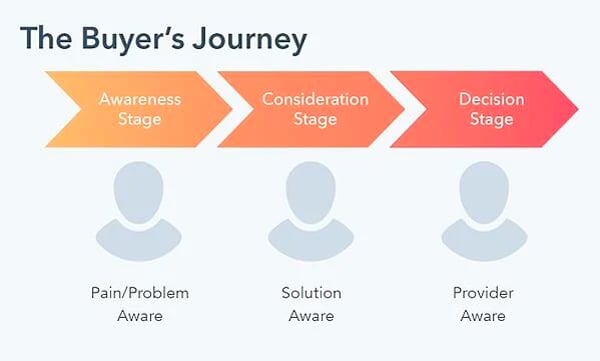
Buyers in each of these stages can be influenced by a lot of different kinds of content. Here is what Hubspot has seen as being the most popular content types for each stage of the buyer journey:
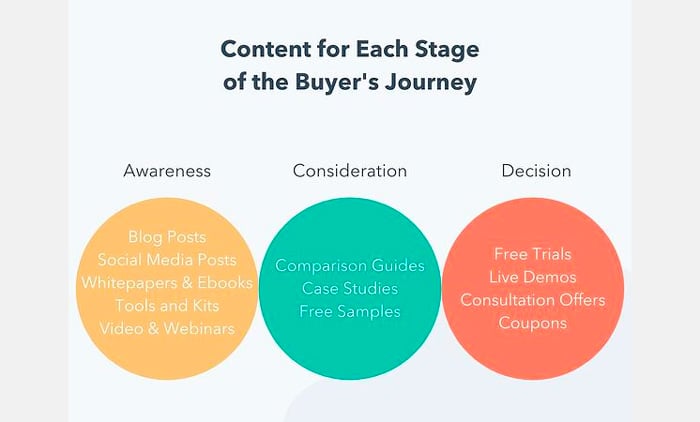
Of course, every business is different and usually, most buyer journeys are different. However, there are commonalities we can take advantage of. Finding those commonalities and using them in your content marketing strategy is one of the cornerstones of successful digital marketing.
To use content to effectively move people through the stages of their buyer journey, it is helpful to employ a Marketing Funnel strategy. To explain what this means, here's a quote from Hubspot:
Whether you subscribe to the funnel or the flywheel methodology, earning business from your prospects comes down to three simple things:
-
- Attracting strangers
- Engaging prospects
- Delighting customers
We often visualize this model as a funnel, but Hubspot has an interesting model that can be visualized as a flywheel, which I think lends itself to a more accurate depiction of a B2B sales cycle:
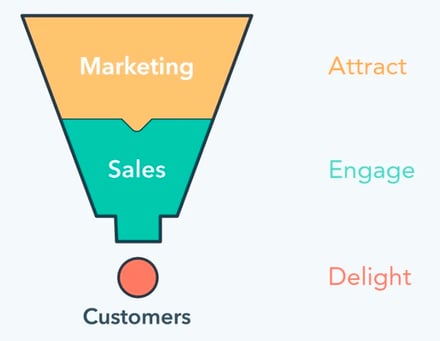
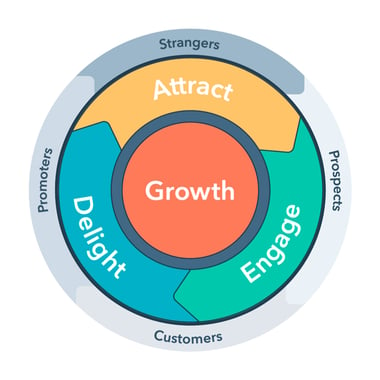
If you haven't taken the Hubspot free Content Marketing Certification course yet, I would highly recommend it. It is very SEO-focused and covers a lot of ground including these topics in much greater depth. But this approach to using marketing funnels to move people and businesses through the buyer journey is a widely accepted model for successful B2B companies.
With that in mind, I'll explain how creating Top of the Funnel content that is not specific to potential customers fits into this model in order to justify creating it from both an SEO and content marketing perspective. This is a critical concept to successful long term B2B content strategy, but is not intuitive to many B2B marketers.
Typically, when we look at the Buyer Journey model, we segment buyers into personas and create content for the marketing funnel specific to each persona. It takes a lot of work, time, energy, and resources to do this effectively at scale. The workload required to consistently produce customer-focused B2B marketing content is often the biggest barrier to finding the bandwidth to produce informational content that is not directly correlated to producing leads.
As a result, many companies rely on their lead generation efforts to produce content that they expect to rank for their target keywords. While this approach has historically worked well for big companies with a lot of link connectivity, it is getting less effective as time goes on. This is especially true for keywords that have an informational bias, meaning that Google prefers to rank informational content as opposed to transactional content in the Top 10 for those terms. We will take a look at some data shortly that illustrates this trend. This disconnect between what Google is ranking and what companies are producing creates unrealistic expectations and causes many companies to fall short of their SEO goals while also putting them at a long-term competitive disadvantage.
I am not saying that marketing content like solutions pages or other core pages of your site can't rank for some of your target keywords, but the propensity for them to do so varies by keyword and needs ongoing evaluation at the keyword level in order to understand whether or not it is a realistic expectation.
If we look at what is ranking in 2021 for the vast majority of highly competitive B2B phrases that are broad concepts with high search volume, we will see that Google tends to rank resource information pages with a slant towards education as opposed to promotional or transactional. This is because Google's machine learning algorithms have a better understanding of the information available for these keywords and, based on their machine learning, have a better idea of what the average search user is looking for. The s not looking for your company, brand, or even product. They are looking for information, and potentially how to solve a problem. For your page to be considered one of the top 10 best resources on the Internet for that keyword, you must provide information that is of value to the majority of searchers, not just the subset that might be your potential customers.
How Does SEO Influence Your B2B Content Strategy?
To get some data to support this hypothesis, I analyzed desktop rankings for 25 high volume, highly competitive terms with B2B intent and then analyzed rankings for those same terms with an additional keyword modifier. I also did a much less thorough analysis of mobile rankings for the same terms and found similar trends although if I am being honest, I didn't spend the time to catalogue the data in the same way just based on time constraints. However, the trends were similar even if the raw numbers were slightly different. Here is what I found:
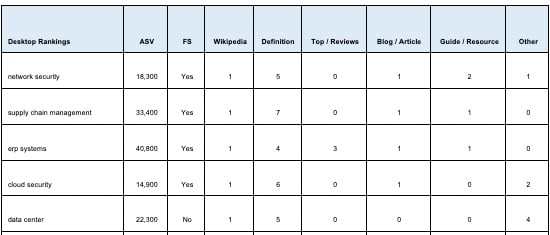 (click on image for full chart)
(click on image for full chart)
Here are the definitions for each of these columns (data was observed on 12/28/20 to 12/30/20):
AVS: Google's Average Search Volume as reported by KeywordTool.io
FS: Featured Snippet (in most cases 16/18, if a Featured Snippet existed it was specific to a definition)
Adding each of the remaining columns will add up to the 10 first page listings that were observed for each keyword:
Wikipedia: Listings for Wikipedia or Investopedia. It should be noted it does not include these properties in cases where they own the Featured Snippets as those were considered separately and reflected in that column.
Definition: 'What Is' pages, glossaries, dictionaries, and other pages where the main focus of the page is the keyword's definition. It also included pillar pages which we will further discuss.
Top / Reviews: Pages that show reviews for multiple products or have Top 10 recommendations (or whatever number they have chosen to evaluate). These pages are especially prevalent in keywords about software.
Blog / Article: Any blog or article page that doesn't fall into one of the other more specific categories. In many cases, especially Definition, blog posts have been put into more specific categories.
Guide / Resource: Pages that serve as comprehensive guides or are predominately resource oriented around the topic of the keyword.
Other: Pages that didn't fall into these categories. In many cases, these are pages that have commercial intent, but many others are pages like college program listings, .edu sites or some other non-commercial content. This is especially true for rankings for information systems management, "industrial engineering", and "business analytics".
I also evaluated whether the rankings had Video Listings, Image Results, People Also Ask Questions, a Knowledge Panel, and a Local Pack:
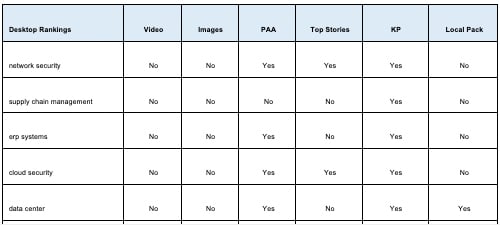 (click on image for full chart)
(click on image for full chart)
Here are the takeaways from the data surrounding the rankings for these 25 terms:
- Informational content dominates the search landscape for these terms
- The only keywords where informational content did not dominate were those that directly implied
some commercial intent like business consulting or seo services. Also commercial real estate was completely different from any other term which speaks to the need to evaluate your keywords individually with the recognition that results vary by industry and topic. - What Is or definition content was the overwhelming winner for these search terms. It's a pattern I have seen for all of my B2B clients for some time.
- There weren't any videos or image packs ranking on page one for these terms. That doesn't mean it's not important to create and optimize videos but currently they don't exist in this landscape (although that is obviously subject to change anytime.).
- People Also Ask questions were found in the Top 10 for 22 / 25 terms and illustrate a huge opportunity.
I did the same analysis for variations of these terms with an additional keyword modifier to show more specific intent (with the exception of "information systems management" which was shortened). Here is that data:
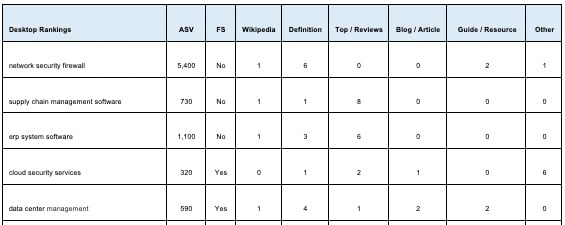 (click on image for full chart)
(click on image for full chart)
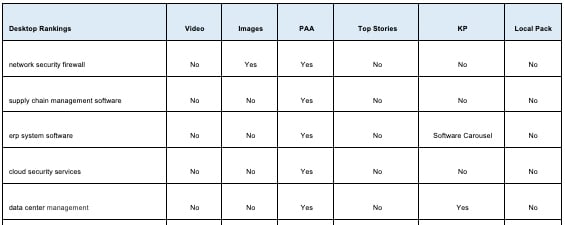 (click on image for full chart)
(click on image for full chart)
Analyzing this data shows similar but slightly different trends based on the specificity of the keywords:
- Definition content was still effective but Top / Review Sites did even better (mostly based on the number of software specific keywords in this list).
- Blog / Article content that was not specific to definitions or reviews was at about the same level of representation. However, for both keyword lists, that content was well behind Definition and Top / Review content.
- People Also Ask (PAA) was still very popular across the second keyword set (20/25).
- The Knowledge Panel was slightly more varied as, in a couple cases, it wasn't a traditional Knowledge Panel but rather a Software Carousel of related offerings. The Risk Management Solutions keyword actually generated a Local Business listing based on my location and the company name. That once again illustrates why keywords need to be evaluated independently and potentially from a variety of locations if they have local bias.
There are other learnings we can derive from this small sample set of terms but the point for our discussion is that for many businesses, the ability to target keywords of interest will depend on their ability to publish the kinds of informational resources that Google prefers for their audience at the keyword level. It's a proof point of my earlier statement and a justification for expenditure of resources:
For your page to be considered one of the top 10 best resources on the Internet for that keyword, you must provide information that is of value to the majority of searchers, not just the subset that might be your potential customers.
To be successful in SEO in today's landscape, we have to consider two additional target personas that fall outside the scope of potential or existing customers and the buyer's journey:
- The average person who is searching for the keywords we want to rank for
- People who might link to our Content
Again, there isn't always a disconnect between these two groups and our target accounts or buyer personas, but in most cases the content must be broader and have a wider appeal while addressing the needs of those two groups specifically.
I want to be clear also that there is a lot of value in publishing thought leadership content that is more specific to products or applications of your products and services for keywords that are likely to be used by potential customers that are further in the buying journey. I am not trying to make the case that all of your marketing efforts should go towards creating resource-based content. But there does need to be at least some consistent application of effort and resources to creating the type of content that will rank well for your higher funnel keywords if you hope to be successful.
Additionally, it is important to understand from an SEO perspective that this kind of content builds Topical Authority which potentially affects rankings for a lot of your target keywords that are more specific to your customers.
What is Topical Authority and Why is it Important for SEO?
To understand Topical Authority and how Google uses it for keyword rankings, I would point you to Bill Slawski's excellent blog post from a few years ago that covers the matter in much greater detail.
For the sake of summarizing that post, I will use the same quote that Bill uses from Google's patent:
In general, an authoritative site is a site that the search system has determined to include particularly trusted, accurate, or reliable content. The search system can distinguish authoritative sites from low-quality sites that include resources with shallow content or that frequently include spam advertisements. Whether the search system considers a site to be authoritative will typically be query-dependent. For example, the search system can consider the site for the Centers for Disease Control, cdc.gov, to be an authoritative site for the queryCDC mosquito stop bites, but may not consider the same site to be authoritative for the query restaurant recommendations. A search result that identifies a resource on a site that is authoritative for the query may be referred to as an authoritative search result.
The first sentence from the quote above is the tip of the iceberg, but it lends itself to the case being made that informational content is of greater interest than just your potential customers, and most likely a necessary component to build authority. The important thing to understand is that Topical Authority is a thing and that it affects search engine rankings.
Bill also has another great post about Google's High Quality Sites patent which references Google's Search Central Blog where you can find this post containing a huge checklist of things to look at when evaluating high quality content which correlates to Authority as evidenced by his evaluation of Google's relevant patents. The following sentence though really underscores the point being made about informational content:
Does this article provide a complete or comprehensive description of the topic?
There are a number of other questions that Google recommends using as a lens to evaluate your content that also dovetail into the idea that creating comprehensive informational content around topics related to your keywords builds authority. By extension, building authority lends itself to increasing the likelihood that your content will rank highly for the specific keywords it is relevant to, including keywords that are more specific to your potential clients.
What are Pillar Pages?
One of the most effective ways to create this kind of authoritative content is by creating Pillar Pages. This concept is defined by Hubspot as a comprehensive resource page that covers a topic in depth which links to high-quality content for supporting subtopic keywords. Another good resource for pillar pages can be found on the SEMRush blog.
I want to make sure everyone understands that these concepts are not specific to Hubspot even though I am using a lot of their examples. A quick Google search for 'What is a Pillar Page' will yield a lot of other great resources. Examples of different variations of pillar pages can be found here.
One distinction to keep in mind: a pillar page is not necessarily a 'What Is' or glossary page that we see ranking well for so many B2B keywords. I may be splitting hairs, but a pillar page often has definitional content as part of the content but typically a pillar page implies a much greater depth of content. It should be noted that many of the pages that rank well in search engines for competitive B2B terms as of Jan 2021 are definition or Topical Navigation Pages.
In fact, I checked on many of the Hubspot examples that are featured in the link above and in many cases those pages were ranking in the Top 10 but they were being outranked by definition pages that were far less comprehensive.
Topical Navigation Pages vs Pillar Pages
While it is true that in some cases that Google is ranking Topical Navigation Pages ahead of Pillar pages, there are good reasons to invest in a long term strategy of developing pillar pages as opposed to Topical Navigation Pages.
To level set on the distinction, we typically refer to Topical Navigation pages as pages that have definition content plus a few other light facts and links to other resources. Pillar Pages, as described above, have more comprehensive content about the topic. Obviously Pillar Pages require a greater outlay of resources to scale across multiple topics.
Although both kinds of pages are ranking well for B2B terms today, as time goes on and things get more competitive in terms of the number of sites that publish definitional content, it stands to reason that search engines will gravitate towards the best, most comprehensive resources possible for a given keyword. Additionally, Pillar Pages generally engage audiences more, have a better opportunity to draw users into additional marketing content, and thus are more prone to generate actual leads across the set of users looking for this content that are your potential customers. Each business case should be evaluated separately given the goals and resources of the company, but all things being equal, Pillar Pages make more sense for your critical areas of focus in terms of long-term SEO strategy. If possible, I would recommend complementing those pillar pages with a broad, user-centric glossary for your audience, especially for keywords where a pillar page wouldn't make sense. This can help build depth of content around a topic, although the traffic that is generated might not be as targeted as other content marketing efforts.
It should be noted that these kinds of pages are going to generate traffic that are much less targeted towards your potential customers. Therefore, you are going to have to employ effective strategies on these pages to pull searchers who are your potential customers into your sales funnel. This includes ensuring including additional calls to action for relevant assets that speak to customer pain points most related to the keyword/page topic.
What are the Most Effective B2B Content Marketing Strategies to Create Successful SEO Performance?
So far, I have made the case that informational content that goes beyond customer focus needs to be an integral part of your SEO Content Strategy for 2021 and beyond. It can be clearly observed in terms of its effectiveness and is congruent with best practices that build authority. However, that content is just part of the overall strategy that you need to be successful. In my experience, it is also the hardest to sell upstream and get buy-in and budget for from management based on perceived value which is why I have spent so much time articulating that value in this article. Hopefully this post gives you some ammunition to make the case. With that being said, let's take a quick, more holistic view of what a good B2B SEO content strategy entails with these 13 important tactics.
- Define your marketing personas and segment your existing content by which stage of the buyer journey you think it's most applicable to.
- Ensure your analytics is set up correctly to track long term attribution so you know what events lead to successful business outcomes. It's very important for B2B companies to fully understand the impact their content is having on the sales cycle. Use this data to validate your assumptions about your personas and your buyer journey content segmentation.
- Research your keywords to understand what kind of content is ranking for those terms and align those keywords to your personas, buyer journey and marketing funnels. Validate the value of those keywords with PPC data whenever possible.
- Create a customer education portal to provide a user-centric umbrella that includes the types of content mentioned which also links to your other content correlated to the buyer's journey.
